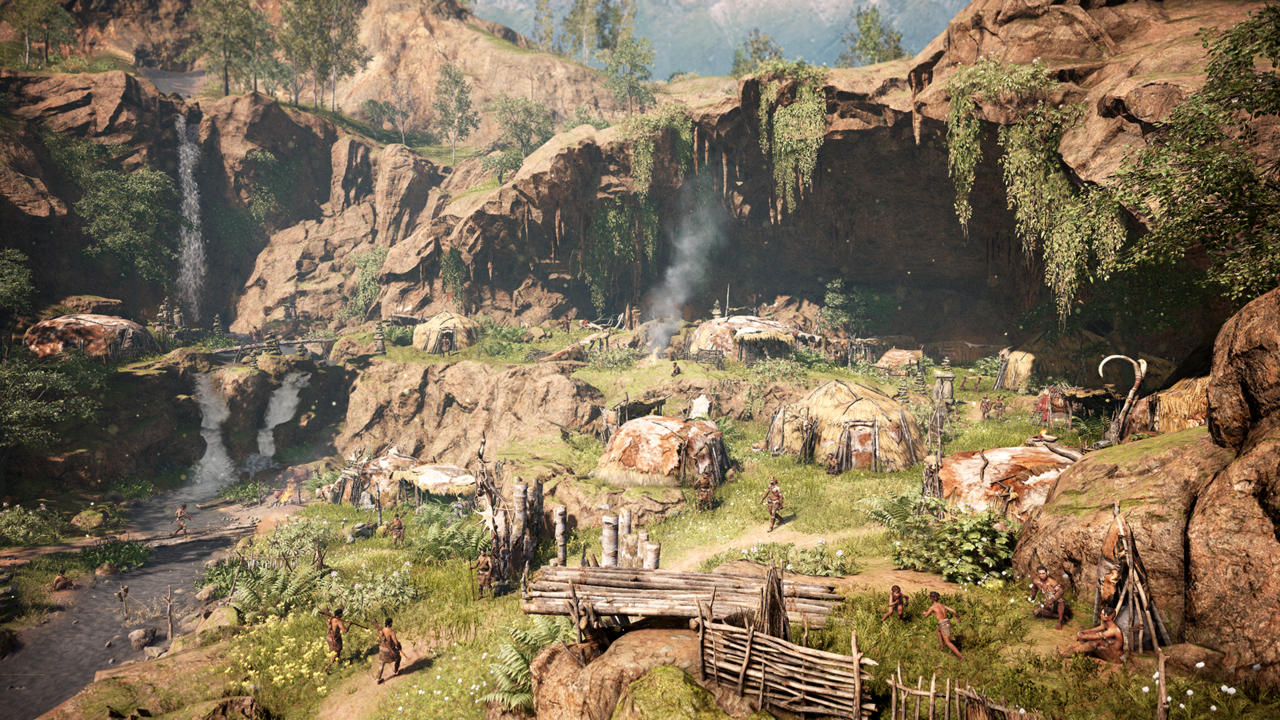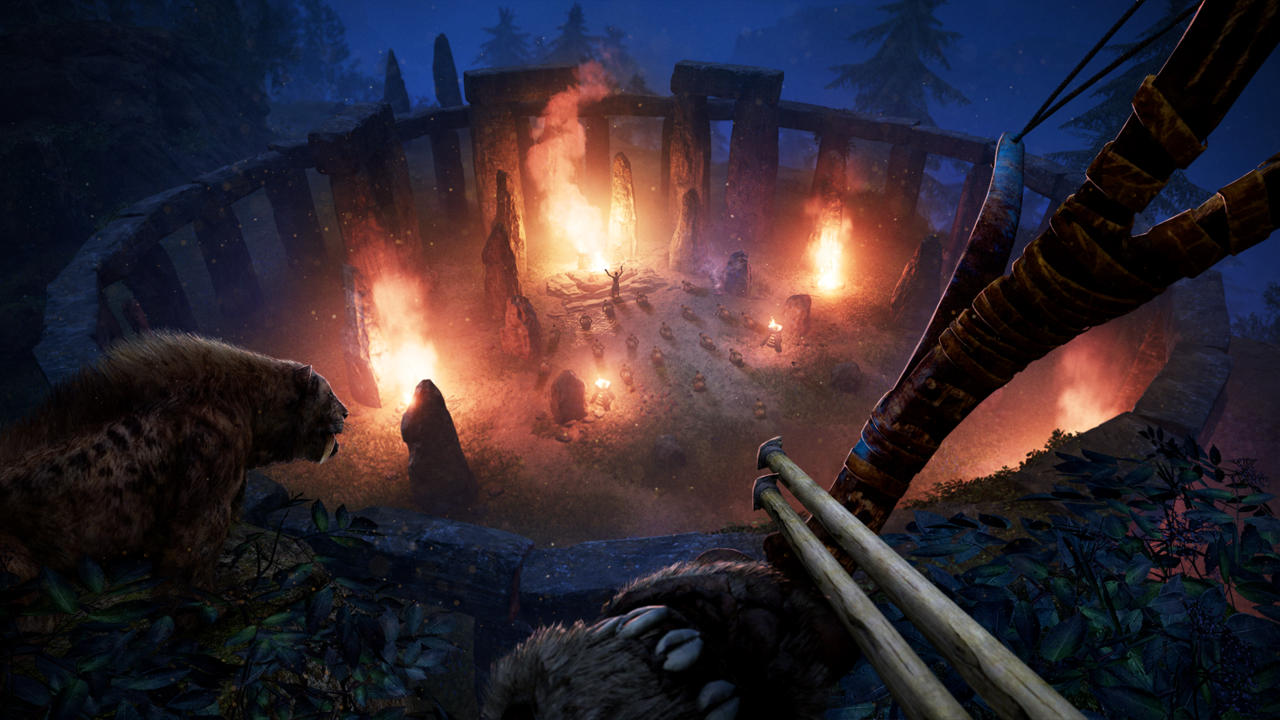Far Cry Primal is a case study in how a game's setting can drive its every layer, from the tone of its story, to the dangers of its world, to the brutality of its combat.
That setting is the Stone Age. It's 10,000 BC, and our protagonist Takkar is searching for the lost members of his Wenja tribe. They're scattered across the Oros Valley, a dense wilderness of forests, swamps, and frozen caves, complete with mammoths and sabertooth tigers. As Takkar, you'll build up a new Wenja village with a multifarious cast of characters.
This reconstruction sets up Primal's progression system. By recruiting the aforementioned Wenja--such as the shaman Tensay or the warrior Karoosh--you'll unlock new items, weapons, and abilities. When you look past the facade, it's essentially a new skin for the franchise's traditional upgrade structure. But it lends character to what could be a lifeless system.
As you build up your tribe from within, you encounter members of other groups, the majority of whom have plans contrary to your own. The identity of each of the game's three tribes, and the political dynamic between them, sets up conflicts in a natural way.

So too does Primal's world. In fact, most of the game's conflicts arise from nature. Primal still uses the basic open-world framework of a traditional Far Cry game, with a cascading series of outposts to capture, weapons to unlock, and upgrades to craft. But the Stone Age setting is far more foreboding than those of past Far Cry games.
Here, vicious animals travel in packs, striking as a collective whole while you slink through the undergrowth toward enemy camps. A day/night cycle also adds more tension to the world: predators are more abundant and aggressive in the darkness. Even now, after dozens of hours in this valley, I still feel anxious as the sun goes down, hoping I have enough animal fat to ignite my club and ward off hulking carnivores.
This focus on survival permeates Far Cry Primal. In the northern wastes, the cold becomes a factor, making each bonfire a glowing beacon of safety as you fight to stay warm. In Primal's lush swampland, avoiding danger means avoiding the water, where underwater predators abound.
There's a fine balance between tension and fun that elevates the whole experience.
As a solitary hunter with simple tools, you're also less equipped to defend yourself than the protagonists of Far Cry 3 and 4. Gone are handguns and grenade launchers--here you have spears, clubs, and slingshots. They not only bring a slow, measured pace to combat, but also add to Primal's overall identity and tone. You're a lone wanderer here, not a walking armory. And although there are more ways to die in this Far Cry than any previous entry, Primal never feels too difficult--there's a fine balance between tension and fun that elevates the whole experience.
On one of Primal's nights, the valley's lurking threats coalesced into a challenge that tested all of my knowledge of the game's survival systems. I was out of wood for spears. I was low on meat for health. I was hundreds of meters from the warmth of the nearest campfire. So by sprinting toward the closest sanctuary on my map--collecting hardwood for torches along the way, and relying on stealth and my few remaining arrows for defense--I trekked through one of the more stressful scenarios the game had to offer. Yet it was thrilling. This was Primal at its best.
The Stone Age setting can also be a detriment, though. The simple toolset serves the game's themes well, but with enough time, it becomes clear how limited your loadout really is. In stealth scenarios, I rely on my silent bow. In open combat, I swing my club wildly. When hunting elk and grizzly bears, I use my spears. There are several more creative tools, but by and large, I find myself relying on the same simplistic options time after time. Primal's reliance on Stone Age combat detracts from the emergent scenarios that occur elsewhere.

There are also powerful enemies whose excessive armor chips away at the fun. I had the best spear upgrades possible, but even at this point in the game's late hours, these armored brutes can take almost 30 seconds to bring down. That's not fun--that's tedium.
But then there's the Beast Master skill tree, and it's the most impactful change to the Far Cry formula. It allows you to tame the creatures in this ancient setting, recruiting them to hunt, fight, and travel with you.
Jaguars kill enemies without alerting larger groups. Wolves pounce on distant archers while you close the gap. You can also ride bears and baby mammoths, clawing and bashing your way through groups of warriors with little resistance. You can use your owl to scout the land ahead of you, tagging more dangerous fighters and dropping makeshift grenades into groups of enemies.
Beast Master abilities are the embodiment of Far Cry Primal's strengths.
Learning the unique abilities of each animal, and taking the time to experiment with them, is essential for your survival. After a while, your predator allies become an extension of yourself. They become the powerful weapons otherwise absent in the the abrasive wilderness.
These abilities are the embodiment of Primal's strengths. When it uses the Stone Age setting to elevate the combat and reinforce the brutality of nature, it thrives. It fosters a give-and-take relationship with the wilderness, granting you the means to survive, but also the threats you have to overcome. That focus on primitive times can become a hindrance at certain points, with limited tools and repetitive combat, but in the end, Far Cry Primal stays true to its callous setting, fleshing out every layer of the captivating world it creates.
Editor's Note: Far Cry Primal is now available on PC, and after taming numerous wild animals, liberating defended enemy outposts, and recruiting several members of the Wenja tribe, it's clear that Primal's PC version not only matches the quality of its console cousins, but slightly outpaces them in several ways, too. 60fps makes the brutal combat smoother. Detailed textures lend a more natural look to the Stone Age environment. Far Cry Primal's setting is its greatest strength, and in its newest form on PC, it's still worth the many hours it takes to explore.